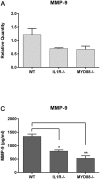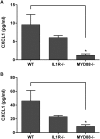MyD88 contribution to ocular surface homeostasis
- PMID: 28796783
- PMCID: PMC5552092
- DOI: 10.1371/journal.pone.0182153
MyD88 contribution to ocular surface homeostasis
Abstract
The cornea must maintain homeostasis, enabling rapid response to injury and microbial insult, to protect the eye from insult and infection. Toll-like receptors (TLRs) are critical to this innate immune response through the recognition and response to pathogens. Myeloid differentiation primary response (MyD88) is a key signaling molecule necessary for Toll-like receptor (TLR) and interleukin-1 receptor (IL-1R)-mediated immune defense and has been shown to be necessary for corneal defense during infection. Here, we examined the intrinsic role of TLR signaling in ocular surface tissues by determining baseline levels of inflammatory mediators, the response to mechanical stimuli, and corneal infection in MyD88-deficient mice (MyD88-/-). In addition, cytokine, chemokine, and matrix metalloproteinase (MMP) expression was determined in ocular surface cells exposed to a panel of TLR agonists. Compared to wild-type (WT) animals, MyD88-/- mice expressed lower MMP-9 levels in the cornea and conjunctiva. Corneal IL-1α, TNFα, and conjunctival IL-1α, IL-2, IL-6, and IL-9 levels were also significantly reduced. Additionally, CXCL1 and RANTES expression was lower in both MyD88-/- tissues compared to WT and IL-1R-/- mice. Interestingly, MyD88-/- mice had lower corneal sensitivities (1.01±0.31 gm/mm2) than both WT (0.59±0.16 gm/mm2) and IL-1R-/- (0.52±0.08 gm/mm2). Following Pseudomonas aeruginosa challenge, MyD88-/- mice had better clinical scores (0.5±0.0) compared to IL-1R-/- (1.5±0.6) and WT (2.3±0.3) animals, but had significantly more corneal bacterial isolates. However, no signs of infection were detected in inoculated uninjured corneas from either MyD88 or IL-1R-deficient mice. This work furthers our understanding of the importance of TLR signaling in corneal defense and immune homeostasis, showing that a lack of MyD88 may compromise the baseline innate response to insult.
Conflict of interest statement
Figures








References
-
- Takeda K, Kaisho T, Akira S. Toll-like receptors. Annu Rev Immunol. 2003;21: 335–376. doi: 10.1146/annurev.immunol.21.120601.141126 - DOI - PubMed
-
- Kawai T, Akira S. The role of pattern-recognition receptors in innate immunity: update on Toll-like receptors. Nat Immunol. 2010;11: 373–384. doi: 10.1038/ni.1863 - DOI - PubMed
-
- Kawasaki T, Kawai T. Toll-like receptor signaling pathways. Front Immunol. 2014;5: 461 doi: 10.3389/fimmu.2014.00461 - DOI - PMC - PubMed
-
- Redfern RL, Reins RY, McDermott AM. Toll-like receptor activation modulates antimicrobial peptide expression by ocular surface cells. Exp Eye Res. 2011;92: 209–220. doi: 10.1016/j.exer.2010.12.005 - DOI - PMC - PubMed
-
- Reins RY, Baidouri H, McDermott AM. Vitamin D Activation and Function in Human Corneal Epithelial Cells During TLR-Induced Inflammation. Invest Ophthalmol Vis Sci. 2015;56: 7715–7727. doi: 10.1167/iovs.15-17768 - DOI - PMC - PubMed
MeSH terms
Substances
Grants and funding
LinkOut - more resources
Full Text Sources
Other Literature Sources
Molecular Biology Databases
Miscellaneous

